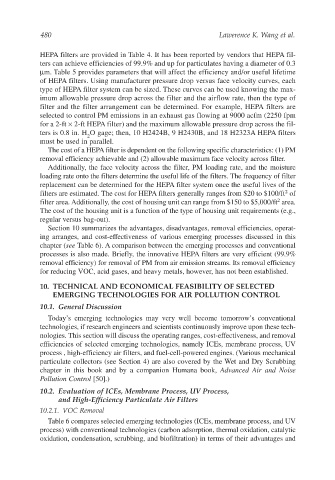Page 508 - Air Pollution Control Engineering
P. 508
12_ch_wang.qxd 05/05/2004 5:27 pm Page 480
480 Lawerence K. Wang et al.
HEPA filters are provided in Table 4. It has been reported by vendors that HEPA fil-
ters can achieve efficiencies of 99.9% and up for particulates having a diameter of 0.3
µm. Table 5 provides parameters that will affect the efficiency and/or useful lifetime
of HEPA filters. Using manufacturer pressure drop versus face velocity curves, each
type of HEPA filter system can be sized. These curves can be used knowing the max-
imum allowable pressure drop across the filter and the airflow rate, then the type of
filter and the filter arrangement can be determined. For example, HEPA filters are
selected to control PM emissions in an exhaust gas flowing at 9000 acfm (2250 fpm
for a 2-ft × 2-ft HEPA filter) and the maximum allowable pressure drop across the fil-
ters is 0.8 in. H O gage; then, 10 H2424B, 9 H2430B, and 18 H2323A HEPA filters
2
must be used in parallel.
The cost of a HEPA filter is dependent on the following specific characteristics: (1) PM
removal efficiency achievable and (2) allowable maximum face velocity across filter.
Additionally, the face velocity across the filter, PM loading rate, and the moisture
loading rate onto the filters determine the useful life of the filters. The frequency of filter
replacement can be determined for the HEPA filter system once the useful lives of the
2
filters are estimated. The cost for HEPA filters generally ranges from $20 to $100/ft of
2
filter area. Additionally, the cost of housing unit can range from $150 to $5,000/ft area.
The cost of the housing unit is a function of the type of housing unit requirements (e.g.,
regular versus bag-out).
Section 10 summarizes the advantages, disadvantages, removal efficiencies, operat-
ing arranges, and cost-effectiveness of various emerging processes discussed in this
chapter (see Table 6). A comparison between the emerging processes and conventional
processes is also made. Briefly, the innovative HEPA filters are very efficient (99.9%
removal efficiency) for removal of PM from air emission streams. Its removal efficiency
for reducing VOC, acid gases, and heavy metals, however, has not been established.
10. TECHNICAL AND ECONOMICAL FEASIBILITY OF SELECTED
EMERGING TECHNOLOGIES FOR AIR POLLUTION CONTROL
10.1. General Discussion
Today’s emerging technologies may very well become tomorrow’s conventional
technologies, if research engineers and scientists continuously improve upon these tech-
nologies. This section will discuss the operating ranges, cost-effectiveness, and removal
efficiencies of selected emerging technologies, namely ICEs, membrane process, UV
process , high-efficiency air filters, and fuel-cell-powered engines. (Various mechanical
particulate collectors (see Section 4) are also covered by the Wet and Dry Scrubbing
chapter in this book and by a companion Humana book, Advanced Air and Noise
Pollution Control [50].)
10.2. Evaluation of ICEs, Membrane Process, UV Process,
and High-Efficiency Particulate Air Filters
10.2.1. VOC Removal
Table 6 compares selected emerging technologies (ICEs, membrane process, and UV
process) with conventional technologies (carbon adsorption, thermal oxidation, catalytic
oxidation, condensation, scrubbing, and biofiltration) in terms of their advantages and

